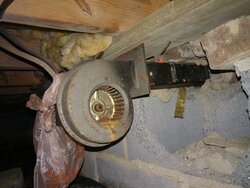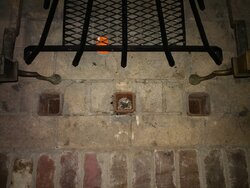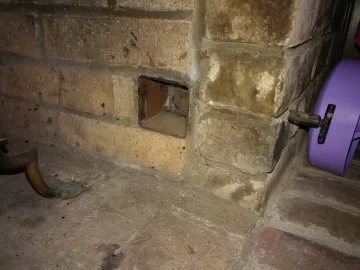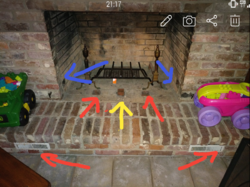Howdy! First post here - thanks for your help, in advance.
My fireplace was originally an open-fire wood burning fireplace. It was built with an integral heat exchanger in the masonry. Somewhere along the line, someone put gas logs in and removed parts of the heat exchanger. Now that I own the house, I've removed the gas logs with the intention of burning wood again.
I can find nothing online that remotely resembles what I have, so I am unable to reconstruct the exchanger without help. Please see attached pictures.
The blower is located under the house in the crawlspace and blows air, I believe, into the center tube (yellow arrow). There is a knob to the side of the fireplace that controls it. I believe the tubes on either side (red arrows) are connected to the vents in the hearth (red arrows). The tubes in either side wall (blue arrows) go directly outside and provide fresh air (?). They have dampers in them controlled by the t-handles on the front of the fireplace.
Clearly I'm missing the portion that sits in the fireplace itself, but I have no idea what it should look like or how it should be routed. Any insight would be appreciated!




My fireplace was originally an open-fire wood burning fireplace. It was built with an integral heat exchanger in the masonry. Somewhere along the line, someone put gas logs in and removed parts of the heat exchanger. Now that I own the house, I've removed the gas logs with the intention of burning wood again.
I can find nothing online that remotely resembles what I have, so I am unable to reconstruct the exchanger without help. Please see attached pictures.
The blower is located under the house in the crawlspace and blows air, I believe, into the center tube (yellow arrow). There is a knob to the side of the fireplace that controls it. I believe the tubes on either side (red arrows) are connected to the vents in the hearth (red arrows). The tubes in either side wall (blue arrows) go directly outside and provide fresh air (?). They have dampers in them controlled by the t-handles on the front of the fireplace.
Clearly I'm missing the portion that sits in the fireplace itself, but I have no idea what it should look like or how it should be routed. Any insight would be appreciated!




Last edited by a moderator:

